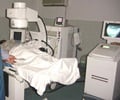Nephrologists were found not to always agree on their interpretation of images from urine sediment tests, which are frequently ordered to evaluate a variety of kidney diseases.

Millions of urine sediment microscopy tests are conducted each year in the United States to diagnose conditions such as urinary tract infections and kidney diseases. The results of these tests are often used to make treatment decisions, such as whether it's necessary to conduct a kidney biopsy or use immunosuppressive medications to treat a patient. While the urine sediment examination has been widely used for decades, there have been few studies looking at the validity of the test or on the variability among nephrologists in their interpretation of the urine sediment test results.
"The urine sediment exam has played a fundamental role in taking care of patients with known or suspected kidney diseases - it's important to ensure that the tests are being interpreted appropriately," said Sushrut S. Waikar, MD, chief of the section of nephrology at Boston Medical Center and the study's corresponding author. The study team prospectively collected urine samples from adult participants who were undergoing a kidney biopsy at Brigham and Women's Hospital in Boston while Waikar was serving as director of Renal Ambulatory Services at the Brigham.
During evaluation of the urine sediment through a microscope, the researchers collected high-resolution images and videos that were used during the analysis. These images and videos were distributed to 14 highly experienced nephrologists at teaching hospitals across the United States. The nephrologists were shown the same images and videos, and asked to identify features in the urine sediment and to provide a single suspected diagnosis based on the urine sediment findings.
The interobserver reliability - based on differences in responses from the nephrologists - ranged from moderate to substantial. For example, important findings, such as white blood cell casts and red blood cell casts - which can indicate serious kidney diseases - were often interpreted differently across nephrologists. Other findings, such as granular casts, showed higher levels of agreement.
"Ideally, the interpretation of the urine sediment should be the same when done by different doctors," added Waikar, who also is the Norman G. Levinsky Professor of Medicine at Boston University School of Medicine. "Our study provides important information that can be used to address these variabilities in order to create a better, more reliable test."
Advertisement
Advertisement
Source-Eurekalert















